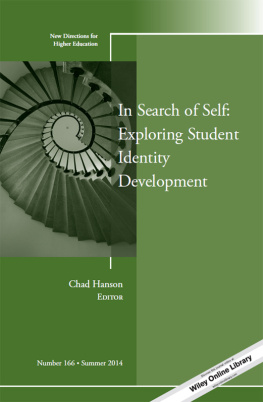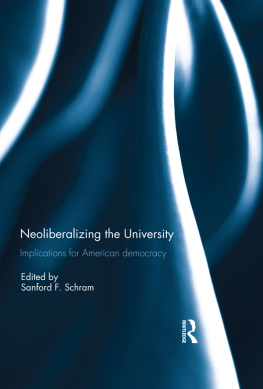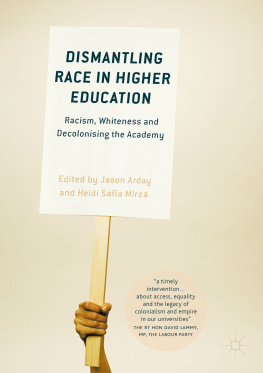
BEYOND EDUCATION
BEYOND EDUCATION
RADICAL STUDYING FOR
ANOTHER WORLD
Eli Meyerhoff
UNIVERSITY OF MINNESOTA PRESS
Minneapolis London
An earlier version of chapter 5 was originally published as Erin Dyke and Eli Meyerhoff, Toward an Anti- and Alter- University: Thriving in the Mess of Studying, Organizing, and Relating with ExCo of the Twin Cities, in Out of the Ruins: TheEmergence of Radical Informal Learning Spaces, ed. Robert H. Haworth and John M.
Elmore, 174 94 (Oakland, Calif.: PM Press, 2017).
Copyright 2019 by the Regents of the University of Minnesota All rights reserved. No part of this publication may be reproduced, stored in a retrieval system, or transmitted, in any form or by any means, electronic, mechanical, photocopying, recording, or otherwise, without the prior written permission of the publisher.
Published by the University of Minnesota Press 111 Third Avenue South, Suite 290
Minneapolis, MN 55401- 2520
http://www.upress.umn.edu
Printed in the United States of America on acid- free paper The University of Minnesota is an equal- opportunity educator and employer.
25 24 23 22 21 20 19
10 9 8 7 6 5 4 3 2 1
Library of Congress Cataloging-in-Publication Data Names: Meyerhoff, Eli, author.
Title: Beyond education : radical studying for another world / Eli Meyerhoff.
Description: Minneapolis : University of Minnesota Press, [2019] | Includes bibliographical references and index. |
Identifiers: LCCN 2018055523 (print) | ISBN 978-1-5179-0202-5 (hc) |
ISBN 978-1-5179-0203-2 (pb)
Subjects: LCSH: Education, HigherAims and objectivesUnited States. |
Education, HigherEconomic aspectsUnited States. | Education, Higher
Political aspectsUnited States. | Capitalism and educationUnited States. |
Alternative educationUnited States.
Classification: LCC LA227.4 .M48 2019 (print) | DDC 378.00973dc23
LC record available at https://lccn.loc.gov/2018055523
Contents
Introduction. Against the Romance of Education: Snapping in and at the University
1. We Are the Crisis: Studying the Impasse of University Politics
2. Disposing of Threats: The Dropout Narrative as Crisis- Management Tool
3. Degrees of Ascent: School Levels as
Preconditions of Capitalism
4. Educational Counterrevolutions: Management through Affective Credits and Debts
5. Experimental College: A Free University for Alternative Modes of Study
with Erin Dyke
Conclusion: Toward an Abolition University
Acknowledgments
Notes
Index
INTRODUCTION
Against the Romance
of Education
SNAPPING IN AND AT THE UNIVERSITY
If our happiness depends on turning away from violence, our happiness is violence.
Sara Ahmed, Resignation Is a Feminist Issue
Feminist scholar Sara Ahmed snapped at her university. After building up frustration over years, in 2016 she publicly called out academias sexism, especially the sexual harassment of students by professors, portending the explosion of the #MeToo movement in 2017. Then she resigned.
After years of trying to address these problems through the proper
institutional channels, she concluded that the issue was not merely a few individuals acting badly but rather an issue of institutional culture, which had become built around (or to enable) abuse and harassment.1 Despite some small victories, she became exhausted with the lack of progress:
so much work not to get very far. In a blog post titled Resignation Is a Feminist Act, she described the moment she snapped: Watching histories be reproduced despite all our efforts was one of the hardest experiences of my academic career well one of the hardest experiences of my life. I just found it shocking. And to complete the story: I originally asked for unpaid leave because doing this work can be demoralising as well as exhausting. But in the course of applying for unpaid leave (and the difficulty of making arrangements in my absence), I felt a snap: I call it feminist snap. My relationship with the institution was too broken. I needed a real break: I had reached the end of the line.
That snap might sound quite violent, dramatic even. Resigning in feminist protest and making public that you are resigning in feminist protest does get attention. It can be a sharp sound; it can sound like a sudden break. In my case, that break was supported by many of my 1
2 INTRODUCTION
colleagues; but not by all. One colleague describes my action as rash,
a word used to imply an action that is too quick as well as careless. Snapping is often a matter of timing. A snap can feel like a moment. But snap is a moment with a history: a history can be the accumulated effect of what you have come up against. And just think: you have to do more, the more you do not get through. You have had hundreds of meetings, with students, with academics, with administrators. You have written blogs about the problem of sexual harassment and the silence that surrounds it. And still there is silence. To resign is a tipping point, a gesture that becomes necessary because of what the previous actions did not accomplish. The actions that did not accomplish anything are not noticed by those who are not involved in the effort. So the action that spills a history, so that it falls out, so there is a fall out, is deemed rash.
Well maybe then: I am willing to be rash. 2
On May 30, 2016, Ahmed resigned after working as a professor for twenty years. Without needing to negotiate anything with her university, she could continue to speak out against sexism in academia and beyond, amplifying her feminist work.
Snapping is one way to respond to an impasse in the university a situation that seems impossible to move past. Ahmed confronted the impasse of sexism (intertwined with those of racism and heteronormativity, among others). Her response of snapping contrasts sharply with her university administrators response to these impasses: pushing everyone to move on. Those who refuse to move on are, in Ahmeds words, deemed rash,
as their action spills a history.
Corey Menafee also famously snapped at his university. On June 13, 2016, he decided the window had to go. During his work break, the thirty-eight- year- old African American service worker at Yale Universitys Calhoun College dining hall used a broomstick to smash a stained- glass window that depicted enslaved people of African descent (Figure 1).
Afterward, he explained how, two weeks prior to his action, a visitor to Yale talked with him about the image:
It was reunion weekend, [a Yale alumnus] came in with his 10- year- old daughter.... [H]e mentioned that image was there way back, like, 10
years ago when he was there as a student, and he said its still there. I mean, you can only imagine the type of emotions that run through an African-

INTRODUCTION 3
FIGURE 1. Corey Menafee and the stained- glass window depicting enslaved people at Yale University. Courtesy of Democracy Now!
American, if I can say that, seeing a picture of two slaves two actual slaves picking cotton.3
After he was arrested and charged with a felony, Menafee resigned from Yale and gave several interviews with local and national news outlets. The nationwide outcry against Yale pressured them to drop the charges and to rehire him. But they did so only on the condition of a gag provision, preventing Menafee from making any further statements to the public
Next page












